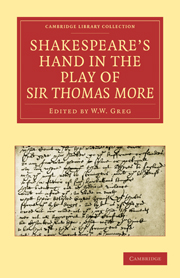Book contents
- Frontmatter
- PREFACE
- Contents
- PLATES
- I INTRODUCTION
- II THE HANDWRITINGS OF THE MANUSCRIPT
- III THE HANDWRITING OF THE THREE PAGES ATTRIBUTED TO SHAKESPEARE COMPARED WITH HIS SIGNATURES
- IV BIBLIOGRAPHICAL LINKS BETWEEN THE THREE PAGES AND THE GOOD QUARTOS
- V THE EXPRESSION OF IDEAS–PARTICULARLY POLITICAL IDEAS–IN THE THREE PAGES AND IN SHAKESPEARE
- VI ILL MAY DAY. SCENES FROM THE PLAY OF SIR THOMAS MORE
- VII SPECIAL TRANSCRIPT OF THE THREE PAGES
- Plate section
I - INTRODUCTION
Published online by Cambridge University Press: 06 December 2010
- Frontmatter
- PREFACE
- Contents
- PLATES
- I INTRODUCTION
- II THE HANDWRITINGS OF THE MANUSCRIPT
- III THE HANDWRITING OF THE THREE PAGES ATTRIBUTED TO SHAKESPEARE COMPARED WITH HIS SIGNATURES
- IV BIBLIOGRAPHICAL LINKS BETWEEN THE THREE PAGES AND THE GOOD QUARTOS
- V THE EXPRESSION OF IDEAS–PARTICULARLY POLITICAL IDEAS–IN THE THREE PAGES AND IN SHAKESPEARE
- VI ILL MAY DAY. SCENES FROM THE PLAY OF SIR THOMAS MORE
- VII SPECIAL TRANSCRIPT OF THE THREE PAGES
- Plate section
Summary
The writers of the successive chapters of this book are interested in the old play of Sir Thomas More mainly because, on various grounds and with varying degrees of confidence, they believe that part of a scene, represented by three pages of the extant manuscript, was composed and written with his own hand by Shakespeare. Yet the play has some interest in its own right and the section in which the three pages occur makes a very popular appeal. Although in the end the hero goes (manfully and merrily) to an unjust death with the full sympathy of the reader, or hypothetical spectator, the play is not a tragedy, hardly even a chronicle history. It is made up of three groups of scenes, each group being fairly homogeneous and the scenes composing it with one exception consecutive. The first group (scenes i and iii–vii) describes from beginning to end the anti-alien riots on the ‘ill May-day’ of 1517, the quelling of which is, with very scant historical justification, attributed to More's pacifying oratory, and represented as promptly rewarded by knighthood (which was conferred on him in 1521), membership of the Privy Council (conferred in 1518) and Lord Chancellorship (conferred in 1529).
- Type
- Chapter
- Information
- Shakespeare’s Hand in the Play of Sir Thomas More , pp. 1 - 40Publisher: Cambridge University PressPrint publication year: 2010First published in: 1923

